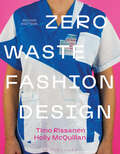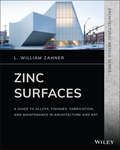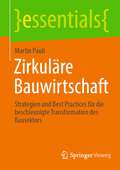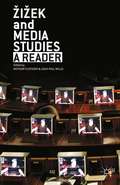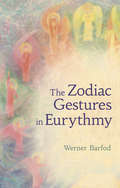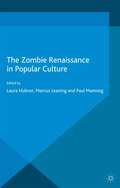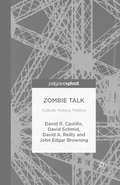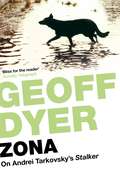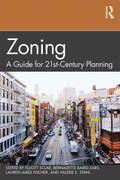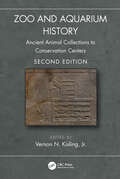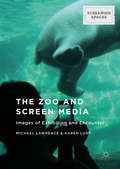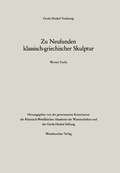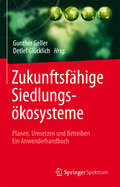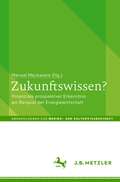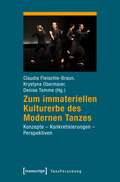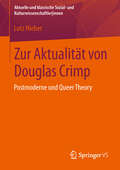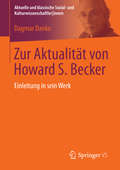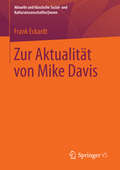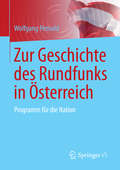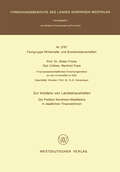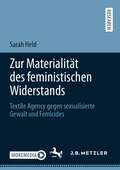- Table View
- List View
Zero Waste Fashion Design
by Timo Rissanen Holly McQuillanZero Waste Fashion Design combines practical examples, flat patterns and more than 20 exercises to help you incorporate this sustainable technique into your portfolio. There are also beautifully illustrated interviews with innovative designers, including Richard Lindgvist, Mary Beth Bentaha and Daniel Desanto to show how sustainable practice continues to evolve within industry.Industry pioneers, Timo Rissanen and Holly McQuillan, offer flexible strategies and easy-to-master zero waste techniques to help you develop your own cutting-edge fashion designs. This updated edition includes new content on integrating 3D design into a zero waste process, additional coverage of the historical context of zero waste around the world, and expands on the related technique of subtraction cutting to make this the ultimate practical guide to sustainable fashion design.
Zinc Surfaces: A Guide to Alloys, Finishes, Fabrication, and Maintenance in Architecture and Art (Architectural Metals Series)
by L. William ZahnerThe leading resource for architects, designers, and artists working with zinc Zinc Surfaces: A Guide to Alloys, Finishes, Fabrication and Maintenance in Architecture and Art combines the latest guidance and information about zinc surfaces into a single and comprehensive resource for architects and artists everywhere. The fifth book in the author’s authoritative Architectural Metals Series, Zinc Surfaces offers a highly visual, full-color guide to ensure architects and design professionals have the information they need to properly maintain and fabricate zinc surfaces. Numerous case studies illuminate and highlight the theoretical principles contained within. Full of concrete strategies and practical advice, Zinc Surfaces provides readers with complete information on topics including: The use of zinc in architecture The history of zinc’s use in design How to choose the right alloy for your purposes Surface and chemical finishes Corrosion resistance of various alloys This book is perfect for architecture professionals, metal fabricators and developers, architecture students and instructors, and designers and artists working with metals.
Zinc Surfaces: A Guide to Alloys, Finishes, Fabrication, and Maintenance in Architecture and Art (Architectural Metals Series)
by L. William ZahnerThe leading resource for architects, designers, and artists working with zinc Zinc Surfaces: A Guide to Alloys, Finishes, Fabrication and Maintenance in Architecture and Art combines the latest guidance and information about zinc surfaces into a single and comprehensive resource for architects and artists everywhere. The fifth book in the author’s authoritative Architectural Metals Series, Zinc Surfaces offers a highly visual, full-color guide to ensure architects and design professionals have the information they need to properly maintain and fabricate zinc surfaces. Numerous case studies illuminate and highlight the theoretical principles contained within. Full of concrete strategies and practical advice, Zinc Surfaces provides readers with complete information on topics including: The use of zinc in architecture The history of zinc’s use in design How to choose the right alloy for your purposes Surface and chemical finishes Corrosion resistance of various alloys This book is perfect for architecture professionals, metal fabricators and developers, architecture students and instructors, and designers and artists working with metals.
Zirkuläre Bauwirtschaft: Strategien und Best Practices für die beschleunigte Transformation des Bausektors (essentials)
by Martin PauliDieses Essential fasst prägnant zusammen, warum die Prinzipien der Kreislaufwirtschaft für die Bauwirtschaft im Kontext von Klimawandel und zunehmender Ressourcenknappheit unabdingbar sind. Es gibt Einblicke in Umsetzungsstrategien und Projektbeispiele, beleuchtet die elementaren Methoden zur Messbarkeit von sektorspezifischen CO2-Emissionen und wirft einen systemischen Blick auf die Wertschöpfungskette Bau sowie die Implikationen, Potenziale und Risiken der Umsetzung.
Zizek and Media Studies: A Reader
by Matthew Flisfeder Louis-Paul WillisFilm, media, and cultural theorists have long appealed to Lacanian theory in order to discern processes of subjectivization, representation, and ideological interpellation. Here, the contributors take up a Zizekian approach to studies of cinema and media, raising questions about power, ideology, sexual difference, and enjoyment.
The Zodiac Gestures in Eurythmy
by Werner BarfodEurythmy is an art form that makes sounds visible. By incorporating zodiac gestures into their art, as indicated by Rudolf Steiner, eurythmists can draw on a deep connection between the earth and the cosmos. The zodiac, as representative of the whole cosmos, is a vital part of human spirituality, acting as the backdrop to human life. But it can be hard to fathom the zodiac's secrets, even through meditation. Barfod draws a parallel between meditative exercises and eurythmy practice, and shows how zodiac gestures in eurythmy can reveal cosmic insights. This is a book for eurythmy teachers and practitioners who want to deepen their art and spiritual work.
The Zombie Renaissance in Popular Culture
by Paul Manning Laura Hubner Marcus LeaningThis collection addresses the significant cultural phenomenon of the 'zombie renaissance' – the growing importance of zombie texts and zombie cultural practices in popular culture. The chapters examine zombie culture across a range of media and practices including films games, music, social media, literature and fandom.
Zombie Talk: Culture, History, Politics
by John Edgar Browning David Schmid David Castillo David A. ReillyZombie Talk offers a concise, interdisciplinary introduction and deep analytical set of theoretical approaches to help readers understand the phenomenon of zombies in contemporary and modern culture. With essays that combine Humanities and Social Science methodologies, the authors examine the zombie through an array of cultural products from different periods and geographical locations: films ranging from White Zombie (1932) to the pioneering films of George Romero, television shows like AMC's The Walking Dead, to literary offerings such as Richard Matheson's I am Legend (1954) and Seth Grahame-Smith's Pride, Prejudice and Zombies (2009), among others.
Zombies in Western Culture: A Twenty-First Century Crisis
by John Vervaeke Filip Miscevic Christopher MastropietroWhy has the zombie become such a pervasive figure in twenty-first-century popular culture? John Vervaeke, Christopher Mastropietro and Filip Miscevic seek to answer this question by arguing that particular aspects of the zombie, common to a variety of media forms, reflect a crisis in modern Western culture. The authors examine the essential features of the zombie, including mindlessness, ugliness and homelessness, and argue that these reflect the outlook of the contemporary West and its attendant zeitgeists of anxiety, alienation, disconnection and disenfranchisement. They trace the relationship between zombies and the theme of secular apocalypse, demonstrating that the zombie draws its power from being a perversion of the Christian mythos of death and resurrection. Symbolic of a lost Christian worldview, the zombie represents a world that can no longer explain itself, nor provide us with instructions for how to live within it. The concept of 'domicide' or the destruction of home is developed to describe the modern crisis of meaning that the zombie both represents and reflects. This is illustrated using case studies including the relocation of the Anishinaabe of the Grassy Narrows First Nation, and the upheaval of population displacement in the Hellenistic period. Finally, the authors invoke and reformulate symbols of the four horseman of the apocalypse as rhetorical analogues to frame those aspects of contemporary collapse that elucidate the horror of the zombie. Zombies in Western Culture: A Twenty-First Century Crisis is required reading for anyone interested in the phenomenon of zombies in contemporary culture. It will also be of interest to an interdisciplinary audience including students and scholars of culture studies, semiotics, philosophy, religious studies, eschatology, anthropology, Jungian studies, and sociology.
Zona: A Book about a Film about a Journey to a Room
by Geoff DyerIn this spellbinding book, the man described by the Daily Telegraph as 'possibly the best living writer in Britain' takes on his biggest challenge yet: unlocking the film that has obsessed him all his adult life. Like the film Stalker itself, it confronts the most mysterious and enduring questions of life and how to live.
Zoning: A Guide for 21st-Century Planning
by Elliott Sclar Bernadette Baird-Zars Lauren Ames Fisher Valerie StahlZoning is at once a key technical competency of urban planning practice and a highly politicized regulatory tool. How this contradiction between the technical and political is resolved has wide-reaching implications for urban equity and sustainability, two key concerns of urban planning. Moving beyond critiques of zoning as a regulatory hindrance to local affordability or merely the rulebook that guides urban land use, this textbook takes an institutional approach to zoning, positioning its practice within the larger political, social and economic conflicts that shape local access for diverse groups across urban space. Foregrounding the historical-institutional setting in which zoning is embedded allows planners to more deeply engage with the equity and sustainability issues related to zoning practice. By approaching zoning from a social science and planning perspective, this text engages students of urban planning, policy and design with several key questions relevant to the realities of zoning and land regulation they encounter in practice. Why has the practice of zoning evolved as it has? How do social and economic institutions shape zoning in contemporary practice? How does zoning relate to the other competencies of planning, such as housing and transport? Where and why has zoning, an act of physical land use regulation, replaced social planning? These questions, grounded in examples and cases, will prompt readers to think critically about the potential and limitations of zoning. By re-forging the important links between zoning practice and the concerns of the urban planning profession, this text provides a new framework for considering zoning in the 21st century and beyond.
Zoning: A Guide for 21st-Century Planning
by Elliott Sclar Bernadette Baird-Zars Lauren Ames Fisher Valerie StahlZoning is at once a key technical competency of urban planning practice and a highly politicized regulatory tool. How this contradiction between the technical and political is resolved has wide-reaching implications for urban equity and sustainability, two key concerns of urban planning. Moving beyond critiques of zoning as a regulatory hindrance to local affordability or merely the rulebook that guides urban land use, this textbook takes an institutional approach to zoning, positioning its practice within the larger political, social and economic conflicts that shape local access for diverse groups across urban space. Foregrounding the historical-institutional setting in which zoning is embedded allows planners to more deeply engage with the equity and sustainability issues related to zoning practice. By approaching zoning from a social science and planning perspective, this text engages students of urban planning, policy and design with several key questions relevant to the realities of zoning and land regulation they encounter in practice. Why has the practice of zoning evolved as it has? How do social and economic institutions shape zoning in contemporary practice? How does zoning relate to the other competencies of planning, such as housing and transport? Where and why has zoning, an act of physical land use regulation, replaced social planning? These questions, grounded in examples and cases, will prompt readers to think critically about the potential and limitations of zoning. By re-forging the important links between zoning practice and the concerns of the urban planning profession, this text provides a new framework for considering zoning in the 21st century and beyond.
Zoo and Aquarium History: Ancient Animal Collections to Conservation Centers
by Vernon N. Kisling JrWild animals have been housed in zoos and aquariums for 5,000 years, fascinating people living in virtually every society. Today, these institutions are at a new milestone in their history. This second edition of Zoo and Aquarium History takes the reader on a journey through the transition of private collections to menageries, to zoos, then zoological gardens, and more recently conservation centers and sanctuaries. Under the direction of Vernon N. Kisling, an expert in zoo history, an international team of authors has thoroughly updated the only comprehensive, global history of animal collections, menageries, zoos, and aquariums. The resulting book documents the continuum of efforts in maintaining wild animal collections from ancient civilizations through today, explaining how modern zoos have developed their mission statements around the core aims of conservation, education, research and recreation. This new edition pulls together regional information, including new chapters on zoological gardens of Canada, Latin America, China, Israel, the Middle East, and New Zealand, along with the cultural aspects of each region to provide a foundation upon which further research can be based. It presents a chronological listing of the world's zoos and aquariums and features many never-before published photographs. Sidebars present supplementary information on pertinent personalities, events, and wildlife conservation issues. The original Appendix has been expanded to include over 1,200 zoos and aquariums, providing an invaluable resource. This is an extensive, chronological introduction to the subject, highlighting the published and archival resources for those who want to know more.
Zoo and Aquarium History: Ancient Animal Collections to Conservation Centers
by Vernon N. Kisling Jr.Wild animals have been housed in zoos and aquariums for 5,000 years, fascinating people living in virtually every society. Today, these institutions are at a new milestone in their history. This second edition of Zoo and Aquarium History takes the reader on a journey through the transition of private collections to menageries, to zoos, then zoological gardens, and more recently conservation centers and sanctuaries. Under the direction of Vernon N. Kisling, an expert in zoo history, an international team of authors has thoroughly updated the only comprehensive, global history of animal collections, menageries, zoos, and aquariums. The resulting book documents the continuum of efforts in maintaining wild animal collections from ancient civilizations through today, explaining how modern zoos have developed their mission statements around the core aims of conservation, education, research and recreation. This new edition pulls together regional information, including new chapters on zoological gardens of Canada, Latin America, China, Israel, the Middle East, and New Zealand, along with the cultural aspects of each region to provide a foundation upon which further research can be based. It presents a chronological listing of the world's zoos and aquariums and features many never-before published photographs. Sidebars present supplementary information on pertinent personalities, events, and wildlife conservation issues. The original Appendix has been expanded to include over 1,200 zoos and aquariums, providing an invaluable resource. This is an extensive, chronological introduction to the subject, highlighting the published and archival resources for those who want to know more.
The Zoo and Screen Media: Images of Exhibition and Encounter (Screening Spaces)
by Michael Lawrence Karen LuryThis book is the first critical anthology to examine the controversial history of the zoo by focusing on its close relationship with screen media histories and technologies. Individual chapters address the representation of zoological spaces in classical and contemporary Hollywood cinema, documentary and animation, amateur and avant-garde film, popular television and online media. The Zoo and Screen Media: Images of Exhibition and Encounter provides a new map of twentieth-century human-animal relations by exploring how the zoo, that modern apparatus for presenting living animals to human audiences, has itself been represented across a diverse range of moving image media.
Zukunftsfähige Siedlungsökosysteme: Planen, Umsetzen und Betreiben Ein Anwenderhandbuch
by Gunther Geller Detlef GlücklichDie gegenwärtige Menschheit und ihre Aktivitäten haben einen gewaltigen Einfluss auf das planetare Ökosystem, z.B. auf den Klimawandel und die Biodiversität. Die ländlichen und insbesondere die städtischen Siedlungen spielen dabei eine Hauptrolle. Die rasante Verstädterung geht ungebrochen weiter. Mehr als die Hälfte der Menschheit wohnt bereits in Städten. Wie können diese also nachhaltig gestaltet werden? Dazu soll dieses Handbuch einen Beitrag leisten.Die Autoren behandeln die Siedlungen in einem umfassenden Sinne als Ökosysteme. Diese sollen nach dem Vorbild reifer natürlicher Ökosysteme funktionieren und werden deshalb planmäßig so gestaltet, dass sowohl eine Symbiose der beiden Teilsysteme (technisch-kulturelles und natürliches) der Siedlung untereinander als auch mit den übergeordneten Systemen möglich wird. Dazu wird auch ein umfassendes Informations- und Qualitätsmanagement eingesetzt, das die bei Planungen übliche Prozess-Steuerung und Partizipation vertieft und erweitert. All dies kann Anwender und Betroffene bei der Planung und Gestaltung von nachhaltigen Siedlungs-Ökosystemen unterstützen.Das Handbuch verfolgt und vermittelt einen ganzheitlichen und integrativen Ansatz, der Fachgebiete wie Architektur und Städtebau, Landschaftsarchitektur und Grünplanung, Umweltschutz, Lebens- und Gesellschaftswissenschaften, Ökologie, Management usw. umfasst. Es behandelt Themen wie Energie-Einsparung, Kreisläufe und Wiederverwendung, nachwachsende Rohstoffe, Flächennutzung und Verkehr, sozio-kulturelle Rahmenbedingungen, wirkliche Partizipation, ganzheitliches Informations-, Stoff- und Qualitätsmanagement. Die Autoren erläutern das Gesamtkonzept , die Schritte der Umsetzung und stellen Werkzeuge für den Anwender bereit.
Zukunftswissen?: Potenziale prospektiver Erkenntnis am Beispiel der Energiewirtschaft (Abhandlungen zur Medien- und Kulturwissenschaft)
by Manuel MackasareVorstellungen von der Zukunft bestimmen das menschliche Handeln. In energiewirtschaftlichen Fragen sind solche Antizipationen besonders relevant: Staaten beschließen Förderprogramme, Unternehmen errichten Kraftwerke, Privatpersonen füllen ihre Öltanks oder ersetzen sie durch Wärmepumpen – stets mit Blick auf ein Morgen, der mitunter trügerisch ist. Kontrovers diskutiert wird, ob es ein Wissen von der Zukunft überhaupt geben und inwieweit es Gegenstand der Wissenschaft sein kann. Die Beiträge dieses Bandes untersuchen Möglichkeit, Methoden und Geltung von Zukunftsentwürfen aus philosophischer, historischer, sozial-, literatur- und medienwissenschaftlicher Perspektive.
Zum immateriellen Kulturerbe des Modernen Tanzes: Konzepte - Konkretisierungen - Perspektiven (TanzForschung)
by Claudia Fleischle-Braun Krystyna Obermaier Denise TemmeDer Moderne Tanz mit seinen pädagogisch-künstlerischen Konzepten (Chladek-System, Elementarer Tanz, Laban/Bartenieff-Bewegungsstudien und Jooss-Leeder-Methode) wurde 2014 von der Deutschen UNESCO-Kommission in die bundessweite Liste des Immateriellen Kulturerbes aufgenommen. Welche Bedeutung haben diese vier Ausprägungen des Modernen Tanzes im zeitgenössischen Tanzgeschehen und in der akademischen Tanz- und Tanzpädagogen-Ausbildung? Die Beiträger_innen des Bandes, darunter Vertreter_innen der vier Systeme als auch der Erziehungswissenschaft, Philosophie, Sportwissenschaft und Tanztherapie, untersuchen die künstlerisch-pädagogischen Konzepte in ihrer Vermittlungspraxis und gehen ihren Entwicklungen und Übersetzungen, Eigentümlichkeiten und Gemeinsamkeiten nach.
Zur Aktualität von Douglas Crimp: Postmoderne und Queer Theory (Aktuelle und klassische Sozial- und KulturwissenschaftlerInnen)
by Lutz HieberDouglas Crimp war in den 1980er Jahren Mitherausgeber der Zeitschrift October. Er formulierte wesentliche Positionen in der Diskussion um den US-amerikanischen Postmodernismus. Dessen künstlerische Praktiken fasste Crimp als Wiederaufgreifen des unvollendet gebliebenen Projekts der historischen Avantgarden, die Diktatur und Krieg aus Europa vertrieben hatten. In der Aids-Krise, die in der zweiten Hälfte der 1980er Jahre virulent wurde, entstand künstlerischer Aktivismus. Damit änderte sich der Aktionsradius für Crimp, der sich auch in der politischen Bewegung engagierte.
Zur Aktualität von Howard S. Becker: Einleitung in sein Werk (Aktuelle und klassische Sozial- und Kulturwissenschaftler innen)
by Dagmar DankoHoward S. Becker gehört zu den vielseitigsten Soziologen der Gegenwart. Er ist in mehrfacher Hinsicht ein Klassiker: Vertreter der sog. zweiten Chicagoer Schule und Weiterentwickler des Symbolischen Interaktionismus, Klassiker einer Devianz- bzw. Kriminalsoziologie, Klassiker der Kunstsoziologie, prominenter Verfechter qualitativer Forschungsmethoden. Das Einführungsbuch stellt seine wichtigsten Theorien dar und zeigt die Bedeutung von Becker für die Kultur- und Sozialwissenschaften der Gegenwart auf.
Zur Aktualität von Mike Davis (Aktuelle und klassische Sozial- und Kulturwissenschaftler innen)
by Frank EckardtMit seinem Buch „City of Quartz“ hat Mike Davis im Jahr 1990 eine intensive Recherche zu aktuellen Themen der Stadtentwicklung anhand von Los Angeles vorgelegt. Dabei hat er nicht nur quasi die zwei Jahre später stattfindenden Unruhen vorhergesagt, sondern eine weitergehende Theorie der post-liberalen Stadt entwickelt, die die Stadtsoziologie im hohen Maß beunruhigt hat. Ist Los Angeles erst der Anfang? Davis ist ein kritischer Historiker, der sich aus der Arbeiterbewegung kommend mit Themen wie der amerikanischen Arbeiterbewegung, der Latino-Immigration und den Auswirkungen des Neo-Liberalismus beschäftigt hat. Seinen theoretischen Ansatz einer kritischen Stadtsoziologie hat er darüber hinaus mit Büchern über San Diego, den „Toten Städten“ und über die weltweiten Slums dargelegt.
Zur Geschichte des Rundfunks in Österreich: Programm für die Nation
by Wolfgang PensoldDas Buch bietet erstmals eine Gesamtschau auf die Geschichte des Österreichischen Rundfunks von den 1920er Jahren bis zur Gegenwart. Es schildert die Entstehung und Entwicklung des Radios ab 1924 und dessen Erweiterung um das Fernsehen ab 1955, und es spannt den Bogen bis zur jüngsten Erweiterung von Radio und Fernsehen um das Internet. Dabei integriert es unterschiedliche Gegenstandsfacetten – technische, politische, ökonomische, soziale und kulturelle – zu einer konsistenten Erzählung. Den roten Faden bildet dabei die Genese der öffentlichen Aufgabenstellung des Rundfunks.
Zur Inzidenz von Landeshaushalten: Die Position Nordrhein-Westfalens in staatlichen Finanzströmen (Forschungsberichte des Landes Nordrhein-Westfalen)
by Dieter FrickeZur Materialität des feministischen Widerstands: Textile Agency gegen sexualisierte Gewalt und Femicides
by Sarah HeldDie Monographie ist ein feministisch-epistemologischer Beitrag zur Untersuchung kritischer und affektiver Gestaltungsbewegungen. Materielle und visuelle Kultur dienen als interventionistische Kunstpraxis von handarbeitenden Feminist*innen. Hierbei werden die limitierten Zuschreibungen von textilen Handarbeiten und Weiblichkeit in Form von Critical Crafting als politischem Aktivismus dechiffriert. Die ephemeren künstlerischen Erzeugnisse formieren sich zum Widerstand der Dinge und agitieren im (teil) öffentlichen Raum gegen sexualisierte Gewalt und Femicides (Frauenmorde, Neologismus aus Female und Homicide) sowie der damit verbundenen gesellschaftlichen Stigmatisierung von Betroffenen.
